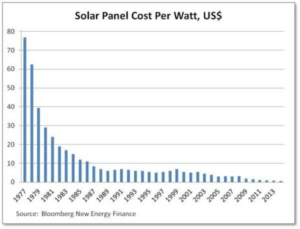A drastic new tariff on imported solar panels could have a profound effect on commercial renewable energy. Let’s take a look at what that could mean for businesses throughout the United States.
Will the Solar Tariff Cloud the Future for Commercial Renewable Energy?
Over the past decade, the future for commercial renewable energy outlook has been very bright. Thanks in part to the 2006 Solar Investment Tax Credit, solar has experienced an average annual growth of about 68 percent over the last ten years. And according to the Bureau of Labor Statistics, solar panel installation has been the fastest-growing occupation in the country with approximately 374,000 people who held solar jobs as of 2016.
But, some feel that bright light is starting to get cloudy.
On January 22, 2018, President Donald Trump announced his approval of a 30 percent tariff on all solar modules and cells imported to the United States. According to the U.S. Trade Representative fact sheet, this tariff will last four years and fall by 5% annually, which drops it to a 15% tariff in 2021.
For those embracing commercial renewable energy, Trump’s decision has left many wondering how it will impact business.
Here’s an overview on the new U.S. solar tariff.
Solar Tariff
 To review, a tariff is simply a tax on imports (or exports). It could either be calculated as a fixed percentage or a fixed dollar amount. Because Trump’s new solar tariff imposes a 30% tax in year one, the impact on prices will actually decrease every year. This wouldn’t be the case if it was a fixed dollar amount.
To review, a tariff is simply a tax on imports (or exports). It could either be calculated as a fixed percentage or a fixed dollar amount. Because Trump’s new solar tariff imposes a 30% tax in year one, the impact on prices will actually decrease every year. This wouldn’t be the case if it was a fixed dollar amount.
Over the past several years, we’ve seen the cost of solar panels fall between 2-6% per year due to advances in technological manufacturing. It has become more affordable than ever and employment in the United States is at record highs. As prices of imported solar panels continue to decrease, the impact of the percentage-based tariff will also fall (which is already set to decrease each year).
According to a recent analysis by Greentech Media, experts estimate that the impact of the tariff in year one will be between $0.10 to $0.12 per watt. By year 4, the tariff’s impact falls to only $0.04 to $0.05 per watt, which results in less than a 2% increase in installation costs.
While 30% sounds high, the reality is that the cost for most commercial solar customers are expected to only be marginally impacted by the tariff and solar will continue to be a smart investment with strong ROI.
Power Ahead with KMB- Commercial Renewable Energy Firm
Sure, the new solar panel import tariffs could potentially dampen growth in the U.S. solar market, but it will be temporary.
The good news? Commercial solar will continue to be one of the best investments that a business can make. And KMB commercial renewable energy firm can help businesses minimize the impact of the new solar tariff.
Combining vast photovoltaic experience with quality engineering consulting services, KMB continues to be a leader in the solar industry. As a full-service engineering firm licensed in the United States and Europe, we provide a national reach with a local touch and take a systematic approach to develop comprehensive solar engineering solutions that line up with unique client needs.
Contact us to find out how KMB can help your business navigate the new solar tariff and maximize ROI for commercial renewable energy.